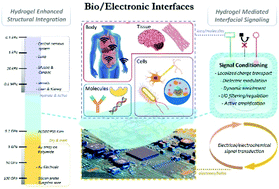Hydrogel facilitated bioelectronic integration
Abstract
The recent advances in bio-integratable electronics are creating new opportunities for investigating and directing biologically significant processes, yet their performance to date is still limited by the inherent physiochemical and signaling mismatches at the heterogeneous interfaces. Hydrogels represent a unique category of materials to bridge the gap between biological and electronic systems because of their structural/functional similarity to biological tissues and design versatility to accommodate cross-system communication. In this review, we discuss the latest progress in the engineering of hydrogel interfaces for bioelectronics development that promotes (1) structural compatibility, where the mechanical and chemical properties of hydrogels can be modulated to achieve coherent, chronically stable biotic-abiotic junctions; and (2) interfacial signal transduction, where the charge and mass transport within the hydrogel mediators can be rationally programmed to condition/amplify the bioderived signals and enhance the electrical/electrochemical coupling. We will further discuss the application of functional hydrogels in complex physiological environments for bioelectronic integration across different scales/biological levels. These ongoing research efforts have the potential to blur the distinction between living systems and artificial electronics, and ultimately decode and regulate biological functioning for both fundamental inquiries and biomedical applications.

- This article is part of the themed collection: Biomaterials Science Emerging Investigators 2021


 Please wait while we load your content...
Please wait while we load your content...